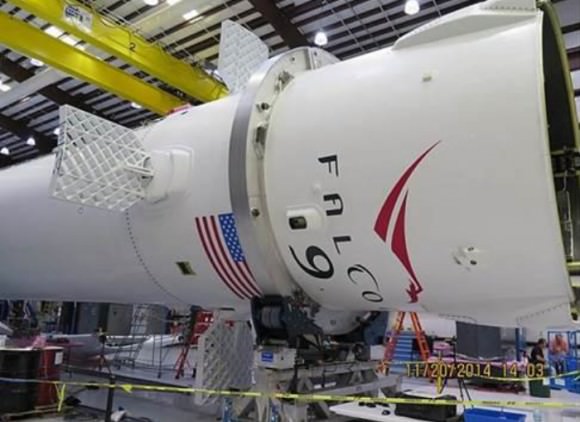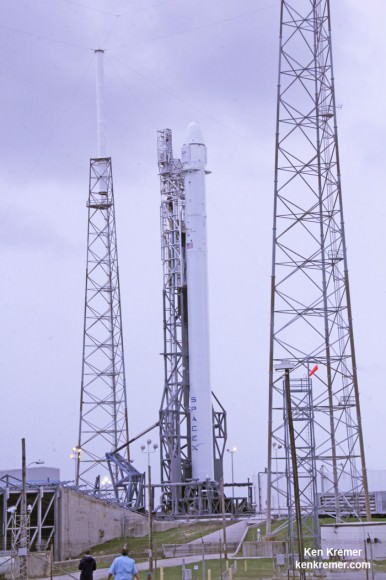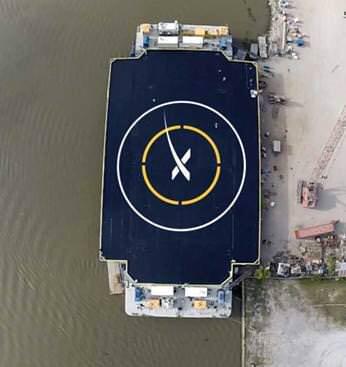KENNEDY SPACE CENTER, FL – In a key test of rocket reusability, SpaceX will attempt a daring landing of their Falcon 9 first stage rocket on an ocean platform known as the “autonomous spaceport drone ship” following the planned Friday, Dec. 19, blastoff on a high stakes mission to the International Space Station (ISS).
The SpaceX Falcon 9 rocket carrying the Dragon cargo freighter is slated to liftoff on its next unmanned cargo run, dubbed CRS-5, to the ISS under NASA’s Commercial Resupply Services (CRS) contract. In a late development, there is a possibility the launch could be postponed to January 2015.
The instantaneous launch window for the Falcon 9/Dragon is slated for 1:20 p.m from Space Launch Complex 40 at Cape Canaveral Air Force Station in Florida.
As the Dragon proceeds to orbit, SpaceX engineers will attempt to recover the Falcon 9 first stage via a precision landing for the first time “on a custom-built ocean platform known as the autonomous spaceport drone ship,” according to a SpaceX statement.

“While SpaceX has already demonstrated two successful soft water landings, executing a precision landing on an unanchored ocean platform is significantly more challenging.”
SpaceX rates the chances of success at “perhaps 50% at best.”
Of course since this has never been attempted before, tons of planning is involved and lots can go wrong.
But this is space exploration, and it’s not for the meek and mild.
It’s time to go boldly where no one has gone before and expand the envelope if we hope to achieve great things.

The 14 story Falcon 9 will be zooming upwards at 1300 m/s (nearly 1 mi/s). Engineers will then relight the Merlin 1D first stage engines to stabilize and lower the rocket.
Four hypersonic grid fins had been added to the first stage and placed in an X-wing configuration. They will be deployed only during the reentry attempt and will be used to roll, pitch, and yaw the rocket in concert with gimballing of the engines.
Here’s a description from SpaceX:
“To help stabilize the stage and to reduce its speed, SpaceX relights the engines for a series of three burns. The first burn—the boostback burn—adjusts the impact point of the vehicle and is followed by the supersonic retro propulsion burn that, along with the drag of the atmosphere, slows the vehicle’s speed from 1300 m/s to about 250 m/s. The final burn is the landing burn, during which the legs deploy and the vehicle’s speed is further.”
“To complicate matters further, the landing site is limited in size and not entirely stationary. The autonomous spaceport drone ship is 300 by 100 feet, with wings that extend its width to 170 feet. While that may sound huge at first, to a Falcon 9 first stage coming from space, it seems very small. The legspan of the Falcon 9 first stage is about 70 feet and while the ship is equipped with powerful thrusters to help it stay in place, it is not actually anchored, so finding the bullseye becomes particularly tricky. During previous attempts, we could only expect a landing accuracy of within 10km. For this attempt, we’re targeting a landing accuracy of within 10 meters.”
Watch for Ken’s ongoing SpaceX launch coverage from onsite at the Kennedy Space Center.
Stay tuned here for Ken’s continuing Earth and planetary science and human spaceflight news.
………….
Learn more about SpaceX, Orion, Antares, NASA missions and more at Ken’s upcoming outreach events:
Dec 18: “SpaceX CRS-5, Orion EFT-1, Antares Orb-3 launch, Curiosity Explores Mars,” Kennedy Space Center Quality Inn, Titusville, FL, evenings


Seems as if the launch will be delayed to January since the static engine test, you know, when the powerful engines roar but the rocket is held in place by gigantic arms, seems to have left some questions unanswered.
http://www.spaceflightinsider.com/missions/commercial/report-spx-5-will-likely-slip-t-early-january/
Confirmed. Launch will occur no earlier than Tuesday, Jan. 6, 2015.
https://blogs.nasa.gov/spacex/